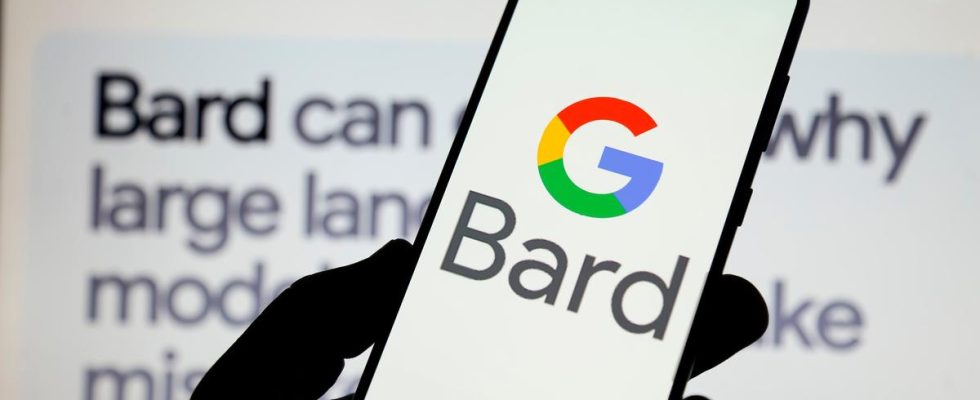Wanted as a product quite distinct from the search engine, Bard differs from its big competitor by its connection to Internet data.
Three months after its launch in the United States and in 180 countries in English, then its expansion to Japanese and Korean languages, Google is launching its conversational robot called Bard in France and in 40 other languages, including German, Arabic, and the Chinese. In total, some 230 countries and territories including Europe and Brazil have been covered since Thursday morning by Google’s response to Open AI and Microsoft’s ChatGPT.
For Europe, it took all this time to adapt to the requirements of the regulations in force, in particular the GDPR. “For the sake of responsibility, notWe also wanted to take the time to take into account the first feedback For continue to learn and improve the quality and speed of Bard.explains Jack Krawczyk, director of product management at Google. On February 8, forced to accelerate its roadmap for generative AI products by the popularity of ChatGPT, Google had the bitter experience, during Bard’s official presentation, of seeing its system of IA to be mistaken in asserting that the James Webb space telescope was the first to have given an image of an exoplanet, when a snapshot had been taken in 2004 by the Very Large Telescope (VLT), an observatory on Earth…
Internet-connected data
Continuously improved since, Google Bard is therefore presented as a separate product, distinct from the Google search engine, accessible via a specific URL (bard. google.com) or from a Google account on your smartphone or computer. More than a chatbot, Google defines it as “a tool to stimulate your imaginationsummarizes Jack Krawczyk. It is not only about answering questions, but above all allowing you to develop ideas“.
Because for Google, it is a question of clearly differentiating the contribution of Bard compared to that of Google search. For a request formulated by a user, Bard does not offer a single response but three different response formulations (“drafts”). “It’s up to the user to decide what works best for them and dig deeper into that first answer base.he continues. The tool offers, in addition, links that redirect to Google Search (as if you had typed a search in the engine), and possibilities to export the responses to Gmail or Google sheet. The answers can also be listened to in audio form. On the other hand, no link to the sources used inside the answers formulated by Bard.
Besides the integration of Google tools and the number of languages offered, the main differentiator of Bard compared to ChatGPT is a connection to data from the Internet (whereas ChatGPT’s data stops at 2021). This does not prevent Bard from giving completely fanciful answers to certain topical questions such as: “Who won yesterday’s stage of the Tour de France?”. “‘Hallucinations’ remain an unsolved problem in the industry, which we obviously want to improveexplains Jack Krawczyk. Google also insists that Bard remains an experiment at this stage.
Collection of data
To obtain supported factual answers, it is therefore better to rely on Google Search. Bard is not there to replace the search engine, although the company knows that in the early days, many user queries are limited to this type of question. Knowing that generative AI systems are dreadful mathematicians, Google also anticipated that some requests would concern calculations. So he built a model inside the model to specifically perform these kinds of tasks. “We believe Bard can occupy a new product categorysays Jack Krawczyk. How to best use it? “Bard helps explore ideas or concepts, or find inspirationhe adds. And to cite as an example this plumber who is looking for the best way to formulate the announcement of bad news to his clients, or this young graduate applying for a job, who wants to know what questions to best prepare for a first interview.
GDPR obliges, European users will be clearly indicated, via a request for initial consent, of the collection of data from their requests and the answers that Bard will provide them. “The only way for us to improve the model is to get the answers to the dataexplains Jack Krawczyk. What if you refuse to give your consent? Google ensures that the user will still be able to use Bard. But only those who agree to the collection will be able to choose to use the product with or without saving conversations for their Google account. For example, to resume or continue a conversation a few weeks or months after a first request.
From Thursday, a few other new features are also coming with the product, but for now only available in English, such as the use of images in queries. It becomes possible, for example, by submitting the label of a bottle of wine, to ask it what are the best dishes to accompany it…
What next? “Bard will be integrated over time into the Google ecosystemadds Jack Krawczyk. For the moment, it is rather the Google tools that will gradually integrate this new universe.
Bard is currently free to use. “Above all, we are looking to see where this new product will bring the most added value. We will then see which is the best model to monetize itconcludes Jack Krawczyk.

